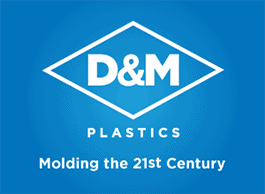3D Printing vs. Injection Molding
| Blogs | Comments Off on 3D Printing vs. Injection MoldingWhen deciding between 3D printing and injection molding for your project, it’s important to consider several factors like cost, materials, and tolerances to ensure the success of your project. D&M Plastics is one of the first to be ISO certified custom injection molders and has over 150 years of combined injection molding experience. We have been an industry leader in plastic injection molding since 1972. 3D printing is suitable for completing early development in a short amount of time (typically a week or two), whereas injection molding can be more time consuming initially, but ready for scalable production once set up.
We will explore several advantages and disadvantages of injection molding vs. 3D printing to help you select the ideal manufacturing process.
Cost
Injection molding is a more cost-effective method when producing parts and products in larger volumes. While the initial cost of plastic injection molding can be higher, it boasts a strong return on investment for customers seeking scalable, precise solutions.
Additional cost variables to consider when selecting injection molding vs. 3D printing include:
- 3D Printing. The upfront cost of 3D printing is lower than that of injection molding, with the main factors in cost per unit being material usage and time to print. Per-unit costs may stay the same or have minimal price reductions regardless of volume and may be less cost-effective for large-scale projects.
- Injection Molding. Mold design, prototyping, and manufacturing can be more expensive initially, depending on the design and resin used. However, the initial cost of the mold can be spread out over large quantities, reducing the cost per part as production quantities expand. Well-built molds can yield millions of parts, which can offer improved ROIs for customers producing parts in larger quantities (50,000-100,000 or more parts in total over the life of the project).
Materials
Material Options for 3D Printing
3D printing currently offers a very limited selection of grades and filaments it can use:
- Plastics and Resins. Plastics like ABS, PETG, PLA, polycarbonate, and nylon work well for producing functional parts and prototypes in small volumes, while resins are ideal for use in dental applications, figurines, and high-detail prototypes.
- Metals. Metal materials are ideal for creating high-strength components, prototypes that require specific characteristics, and applications that mimic metal aesthetics. Metal options include aluminum to stainless steel and titanium.
- Special Filaments. Filaments with unique properties (like biocompatible materials, conductive filaments, and wood-fill) support innovation in fabrication processes for medical devices, electronic components, and educational model production.
Consistent Quality with Injection Molding
Injection molding offers consistent, high-quality part production and supports a wider variety of plastic materials. Common injection molding materials include:
- Thermoplastics. Injection molding offers various plastics, including ABS, PC, PE, PP, PS, and nylon. These offer good performance and value for a range of applications.
- Thermosets. Epoxies and phenolics are thermosets known for their heat and chemical resistance. However, these materials are not easy to recycle.
- Metals. While less common than thermoplastic materials, aluminum and magnesium are also suitable for use with injection molding. Fabricators can use them to create larger volumes of components while maintaining a high strength-to-weight ratio.
Tolerances
Injection molding is more suitable for producing parts with fine details and smooth surfaces than 3D printing. It is critical to consider the tolerances and aesthetics of the components when selecting between 3D printing vs. injection molding.
Manufacturers must accept the limitations of 3D printing to embrace its flexibility. It offers exceptional freedom of design but can be challenging to use when achieving tight tolerances. Selecting the right printing technology can assist in achieving tight tolerances. For instance, digital light processing (DLP) and stereolithography (SLA) offer improved precision over fused deposition modeling (FDM) technology. Using thinner layers can result in a smooth surface and tighter tolerances but may require longer print times.
Injection molding is well-known for its dimensionally accurate component production. Nevertheless, certain materials warp and shrink after cooling. Warpage and shrinkage of injection molded parts can be easily managed with a well-designed mold, delivering replicable parts with virtually identical dimensional accuracy. Additional maintenance protocols (such as routinely calibrating printers) may be needed to ensure consistent 3D printed parts with fewer errors.
3D Printing and Injection Molding Services From D&M Plastics
When choosing between 3D printing and injection molding, consider cost, materials, and desired tolerances, as well as the stage of development for the part and any time requirements.
D&M Plastics can help you select the ideal manufacturing method for your product or component. Our exceptional team has the expertise to deliver a successful project. Contact us or request a quote to speak with an expert about your project needs.
When deciding between 3D printing and injection molding for your project, it’s important to consider several factors like cost, materials, and tolerances to ensure the success of your project. D&M Plastics is one of the first to be ISO certified custom injection molders and has over 150 years of combined injection molding experience. We have […]
